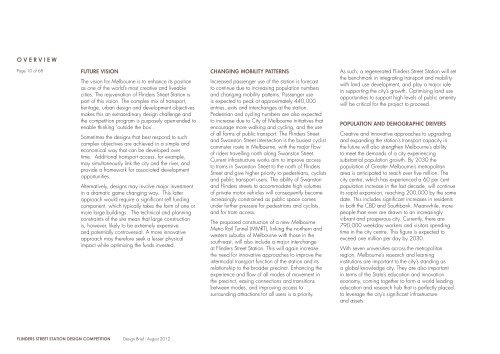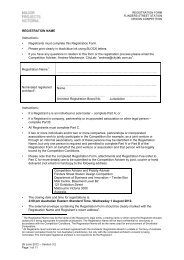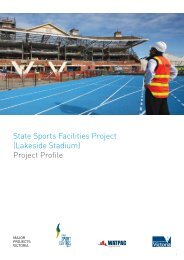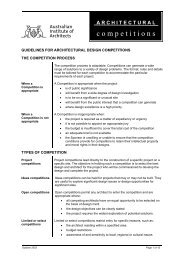Flinders Street Station Design Competition - Design Brief - August
Flinders Street Station Design Competition - Design Brief - August
Flinders Street Station Design Competition - Design Brief - August
- No tags were found...
Create successful ePaper yourself
Turn your PDF publications into a flip-book with our unique Google optimized e-Paper software.
OverviewPage 10 of 68Future visionThe vision for Melbourne is to enhance its positionas one of the world’s most creative and liveablecities. The rejuvenation of <strong>Flinders</strong> <strong>Street</strong> <strong>Station</strong> ispart of this vision. The complex mix of transport,heritage, urban design and development objectivesmakes this an extraordinary design challenge andthe competition program is purposely open-ended toenable thinking ‘outside the box’.Sometimes the designs that best respond to suchcomplex objectives are achieved in a simple andeconomical way that can be developed overtime. Additional transport access, for example,may simultaneously link the city and the river, andprovide a framework for associated developmentopportunities.Alternatively, designs may involve major investmentin a dramatic game changing way. This latterapproach would require a significant self fundingcomponent, which typically takes the form of one ormore large buildings. The technical and planningconstraints of the site mean that large constructionis, however, likely to be extremely expensiveand potentially controversial. A more innovativeapproach may therefore seek a lesser physicalimpact while optimising the funds invested.Changing mobility patternsIncreased passenger use of the station is forecastto continue due to increasing population numbersand changing mobility patterns. Passenger useis expected to peak at approximately 440,000entries, exits and interchanges at the station.Pedestrian and cycling numbers are also expectedto increase due to City of Melbourne initiatives thatencourage more walking and cycling, and the useof all forms of public transport. The <strong>Flinders</strong> <strong>Street</strong>and Swanston <strong>Street</strong> intersection is the busiest cyclistcommuter route in Melbourne, with the major flowof riders travelling north along Swanston <strong>Street</strong>.Current infrastructure works aim to improve accessto trams in Swanston <strong>Street</strong> to the north of <strong>Flinders</strong><strong>Street</strong> and give higher priority to pedestrians, cyclistsand public transport users. The ability of Swanstonand <strong>Flinders</strong> streets to accommodate high volumesof private motor vehicles will consequently becomeincreasingly constrained as public space comesunder further pressure for pedestrians and cyclists,and for tram access.The proposed construction of a new MelbourneMetro Rail Tunnel (MMRT), linking the northern andwestern suburbs of Melbourne with those in thesouth-east, will also include a major interchangeat <strong>Flinders</strong> <strong>Street</strong> <strong>Station</strong>. This will again increasethe need for innovative approaches to improve theintermodal transport function of the station and itsrelationship to the broader precinct. Enhancing theexperience and flow of all modes of movement inthe precinct, easing connections and transitionsbetween modes, and improving access tosurrounding attractions for all users is a priority.As such, a regenerated <strong>Flinders</strong> <strong>Street</strong> <strong>Station</strong> will setthe benchmark in integrating transport and mobilitywith land use development, and play a major rolein supporting the city’s growth. Optimising land useopportunities to support high levels of public amenitywill be critical for the project to proceed.Population and demographic driversCreative and innovative approaches to upgradingand expanding the station’s transport capacity inthe future will also strengthen Melbourne’s abilityto meet the demands of a city experiencingsubstantial population growth. By 2030 thepopulation of Greater Melbourne’s metropolitanarea is anticipated to reach over five million. Thecity centre, which has experienced a 60 per centpopulation increase in the last decade, will continueits rapid expansion, reaching 200,000 by the samedate. This includes significant increases in residentsin both the CBD and Southbank. Meanwhile, morepeople than ever are drawn to an increasinglyvibrant and prosperous city. Currently, there are790,000 weekday workers and visitors spendingtime in the city centre. This figure is expected toexceed one million per day by 2030.With seven universities across the metropolitanregion, Melbourne’s research and learninginstitutions are important to the city’s standing asa global knowledge city. They are also importantin terms of the State’s education and innovationeconomy, coming together to form a world leadingeducation and research hub that is perfectly placedto leverage the city’s significant infrastructureand assets.FLINDERS STREET STATION DESIGN COMPETITION <strong>Design</strong> <strong>Brief</strong> - <strong>August</strong> 2012






